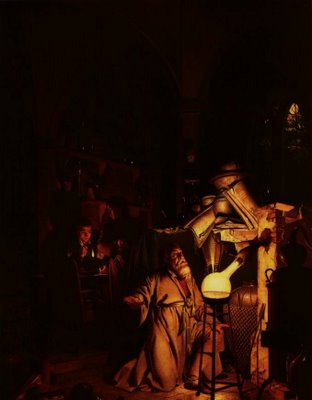A Walk in the Woods

It's my birthday - 35 years old, half way through if we take the Biblical three score years and ten to be our guide (I do not) - making me officially middle aged by Christian reckoning. There are an increasing number of gray hairs in my beard, I may choose to consider these as evidence of increased sagacity.
35 is a 7 year, another point in what some read as important lunar cycles - positing transformation points at ages of 7, 14, 21, 28, 35, 42 etc. Is this just arbitrary? Whenever we reach a point of reflection in our life, it is easy to seek out some exterior system that might validate our introspection: 28-30 - its Saturn Return; 33 - the age Jesus achieved Christhood, or Gautama Buddhahood; 35 - what can I find? seven year lunar cycles... anything else?
In Dane Rudhyar's reading of the words of Krishna in the Bhagavad Gita, the age of 35 is one of the seed points of the cycle of life, the Summer point of fecundation.
At the point of mid-life the conscious self of man, like Dante, explores his depths and his heights and joins the other self that pours down from the heart of Light.
(A Philosophy of Operative Wholeness (1930))
Well maybe Dane. But the evocation of Dante brings a more familiar feeling to mind, the opening tercet in Longfellow's translation of the Divine Comedy:
MIDWAY upon the journey of our life
I found myself within a forest dark,
For the straightforward pathway had been lost.
Recognising that these are some of the most quoted lines in Western literature however, I am removed slightly from my solipsism and forced to reflect on the universality of the experience referred to. Again I question - was there ever this straight-forward path? are we any more lost at mid-life than we are at any other time? All the previous moments of confusion wash back in, the tidal pulse of life's questioning. Jung saw the analytic process as not a linear path, 'the straightforward pathway', but a circular or cyclical journey, and so too our personal meditations on ourselves and the world.

In Jung's work on alchemy and the process of individuation, he writes of the movement from the albedo to the rubedo in a way that may remind us of the Rudhyar lines quoted above:
The growing redness (rubedo) which now follows demotes an increase of warmth and light coming from the sun, consciousness. This corresponds to the increasing participation of consciousness, which now begins to react emotionally to the contents produced by the unconscious.
(Mysterium Coniunctionis (1956))
So is this mid-life madness, more Rubedo? At first the process of integration is fiery conflict - this confusion. But amidst all this conflict and confusion there is soul-making, there is the work. Of course this work is always ongoing, and of course it cycles around again and again - but cycles are not necessarily repetitions. This cycling may be, to take another archetypal image, a spiral or spirals - like Dante we spin through our infernos, purgatories, paradises - repeating patterns but not exiting from the spirals as we were when we entered them, who we were when we entered them.
When we leave the path, lose ourselves in the woods, appear to be going around in circles – perhaps this is not such a bad thing. When we try and force shape and understanding on our experience, try and systemise ourselves, adjust to the “normal”, straight forward, socially acceptable routes mapped out for us - we may miss our own instinctual recognition of our needs, of the way forward for us. So let’s end today’s walk with Dante again:
As the geometrician, who endeavours
To square the circle, and discovers not,
By taking thought, the principle he wants,
Even such was I at that new apparition;
I wished to see how the image to the circle
Conformed itself, and how it there finds place;
But my own wings were not enough for this,
Had it not been that then my mind there smote
A flash of lightning, wherein came its wish.
Here vigour failed the lofty fantasy:
But now was turning my desire and will,
Even as a wheel that equally is moved,
The Love which moves the sun and the other stars.
James Piers Taylor, 12th October 2006, London
IMAGES: Dante Astray in the Dusky Wood (1861) by Gustave Doré; The Alchemist in Search of the Philosopher's Stone (1771) by Joseph Wright.



0 Comments:
Post a Comment
<< Home